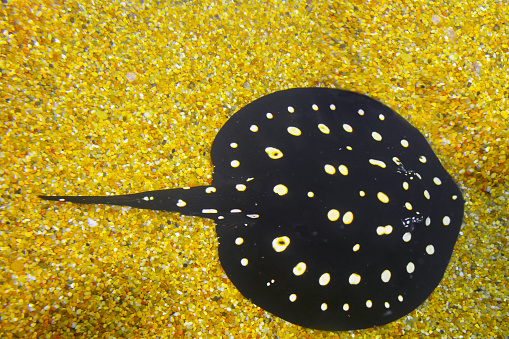ANIMAL: White-Blotched River Stingray/Xingu River Ray/Polka Dot Stingray Potamotrygon leopoldi Type of Animal: Ray Habitat: Rivers, river bottoms, sand banks, slow-moving tributaries w/ sand/mud substrate, river shallows, flooded forest, terrestrial lakes/ponds formed by receding flood waters Location(s): Xingu, Fresco, Curua, & Iriri rivers of N Brazil Appearance: Black w/ white blotchy polka-dot like spots, brownish-dusky belly, looks like floating disc Food/Diet: Fish, crustaceans, worms, snails, clams, mussels, aquatic insect larvae Status in Wild: Stable Conservation: Breeding in aquariums, marine parks, & zoos Lifestyle: Solitary or small groups of 2-8 rays. Juveniles found in groups of 7-20 rays. Additional Info: Called: Male Female Young: Pup Group: School/Fever Weight: Male: 40 lbs Female: 44 lbs Gestation: 3-12 months Life Span: 5-15 years Width: Male: 1.47 ft Female: 2.13 ft Young: 9 in Body Length: Male: 2.46 ft Female: 3.28 ft Tail Length: Male: 3 ft Female: 4 ft They’re ovoviviparous, meaning young nourished by egg yolks in mom’s body, coming out as live young. Females give birth to 4-12 pups. They’re ambush predators. While stable, potential threats are water pollution, habitat loss/degradation, collection for aquarium/pet trade, dam construction, killing out of fear, overfishing, agriculture, mining, & logging. Like other freshwater stingrays, they have great eyesight. Ampullae of Lorenzini located on skin around nose/mouth allow them to detect minute electric fields generated by other living things. Sensory detection notifies them of possible prey nearby. Usually hunt at night. Males have claspers used to internally fertilize females. Sexually mature at 10 months old. Males bite edges of female disc to encourage them to accept. Then male bites/hold on to female while maneuvering himself to impregnate a uterus w/ single clasper, belly to belly. Mating itself lasts less than half a minute. Fun Fact(s): Scientific name means Leopold’s River Stingray, which is another name for this species. Other names-Black Diamond Stingray, Black Devil Stingray, Black Ray, Yellow-Spotted Black Amazon Stingray, & Eclipse Ray. No 2 stingrays have same spot pattern. Known to be fast learners. While docile, these animals & close relatives inflict more human injuries yearly than any other animals in Amazonian rivers, most likely because they bury themselves in sand/mud & inadvertently get stepped on. Often more feared than piranhas due to powerful painful sting. Younger animals have more toxic venom than older animals. Freshwater stingray venom more potent than those of saltwater stingrays due to having more venom secreting cells along barbs. If cut/lost in flesh of threat, barbs can grow back within a few months.
